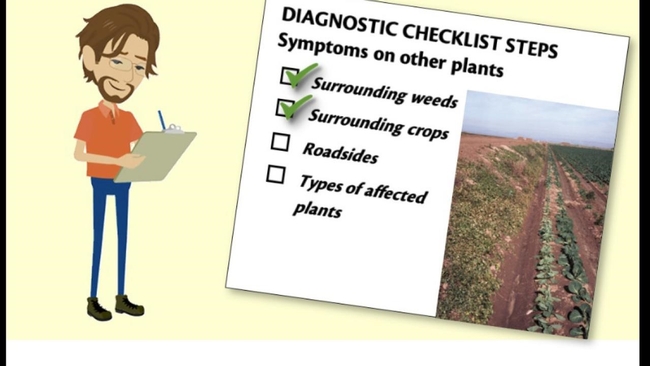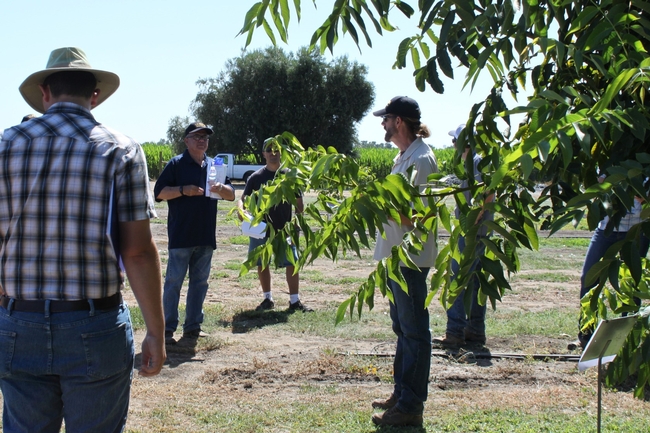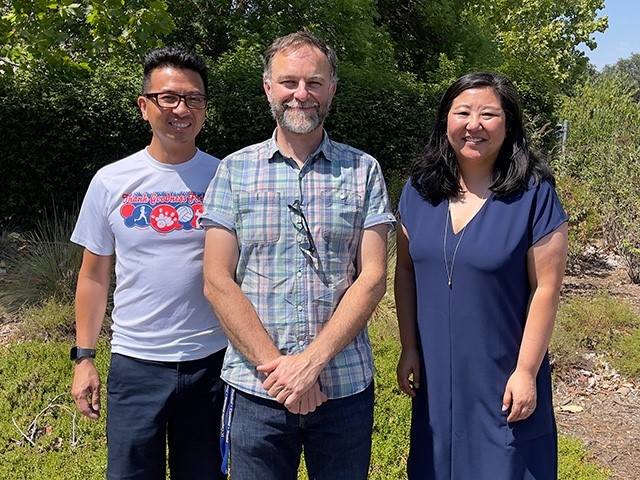'Herbicide Injury" tutorial builds on popular website
A cartoon character that looks suspiciously like a Department of Plant Sciences professor leads an animated, online tutorial that recently won a 2022 Gold Award from the Association for Communication Excellence. UC Davis weed experts Kassim Al-Khatib and Brad Hanson worked with the University of California Statewide Integrated Pest Management Program to create “Diagnosing Herbicide Injury,” which debuted in October 2021 on Extension Foundation Campus.
The free, self-guided course explains how herbicides may – or may not – be the culprits behind plant maladies. The cartoon guide walks viewers through interactive slides describing common herbicide-related problems, their diagnoses and solutions; short quizzes solidify the viewer's knowledge at the end of each module. The course fulfills continuing education credits for several institutions; those who complete the course can get a certificate for a small fee.
“This project builds on previous work in which I developed an interactive website to help people investigating herbicide injury symptoms,” said Al-Khatib, the Melvin D. Androus Endowed Professor for Weed Science. The website, built in 2015 by programmer Chinh Lam of UC's Integrated Pest Management program, offers 1,500 photographs showing herbicide injuries in more than 150 crop and ornamental plants. Such problems often are caused by incorrect application, drift and carry-over from a previous crop. Visitors can look for information by crop, herbicide, chemistry, mode of action and how symptoms appear. Each year, Al-Khatib adds hundreds of new images.
“As Extension weed scientists, we often get questions about herbicide injury,” added Hanson, a professor of UC Cooperative Extension. “If you suspect an herbicide and want to find out what the injury symptoms look like, this is a really useful website.”
Al-Khatib's site proved widely popular in the agricultural community. That lead to a handful of in-person short courses the two professors offered through the UC Weed Research and Information Center, focusing on symptoms that appear in the field.
Separately, beginning in 2016, the information technology people at UC IPM were starting to put their collection of in-person courses online. They were experimenting with different formats to make online learning more attractive, said team member Petr Kosina, who developed the award-winning video. “My vision was, we needed to make the online courses more interactive, more entertaining and more engaging,” said Kosina, a plant biologist with a degree in instructional design.
Video course has ‘thousands' of potential viewers
The gold-winning video is among more than two dozen courses the UC IPM team has put online in recent years. Other team members involved in the course's development were Kimberly Steinmann, Cheryl Reynolds and Tunyalee Martin.
Programmer Chinh Lam, left, of UC's Integrated Pest Management program, built the original website about herbicide injuries. Petr Kosina, center, and Tunyalee Martin are part of the UC IPM technology team that created the gold-winning video, based on the website's information.
The video's purpose is to help people distinguish herbicide-caused injuries from those caused by dozens of other potential factors, including insects, diseases, fertilizers, poor nutrition and environmental stressors such as drought. The course describes common patterns of herbicide injury and how to use laboratory analysis to confirm potential culprits. Its audience: growers, pest control advisers, sales representatives for chemical companies, field investigators and insurance adjusters who need guidance gathering information. Nearly 170 people finished the course in 2021, and more than 80 had enrolled by mid-2022, Kosina said. "There are several thousand potential learners in California alone," Martin wrote in the award application.
The animated, cartoon guide is a stock image that Kosina doctored to riff off of Hanson's beard and rectangular glasses; Hanson also narrates. The character brings a human element to the video and puts viewers at ease. Research shows that a cartoonish approach to a topic can improve adult viewers' response when they might see the material as intimidating or dry.
Viewers, indeed, have become fans. Here are a few comments from people who have taken the online course:
- “The avatar is a kick.”
- “I do not care for cartoons, but Brad's ‘character' was great! And his manner of speaking was great – grade A+.”
- “The use of several different types of multi-media concepts combined with the methodical and well-thought-out delivery of technical information really helps keep the online participant engaged.”
The course has been approved for continuing education units by the California Department of Pesticide Regulation, the Certified Crop Adviser program of the American Society of Agronomy, and the Arizona Department of Agriculture.
RELATED LINKS: Watch a short video by the UC IPM team that describes the course, how they approached the design and addressed accessibility and diversity.
Media Resources: Trina Kleist, tkleist@ucdavis.edu, (530) 754-6148 or (530) 601-6846.
Original source: UCD Department of Plant Sciences News. July 26, 2022


